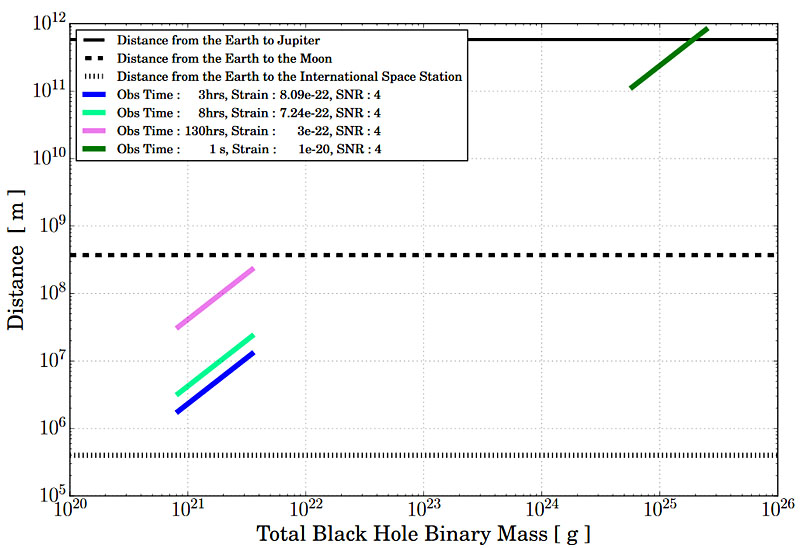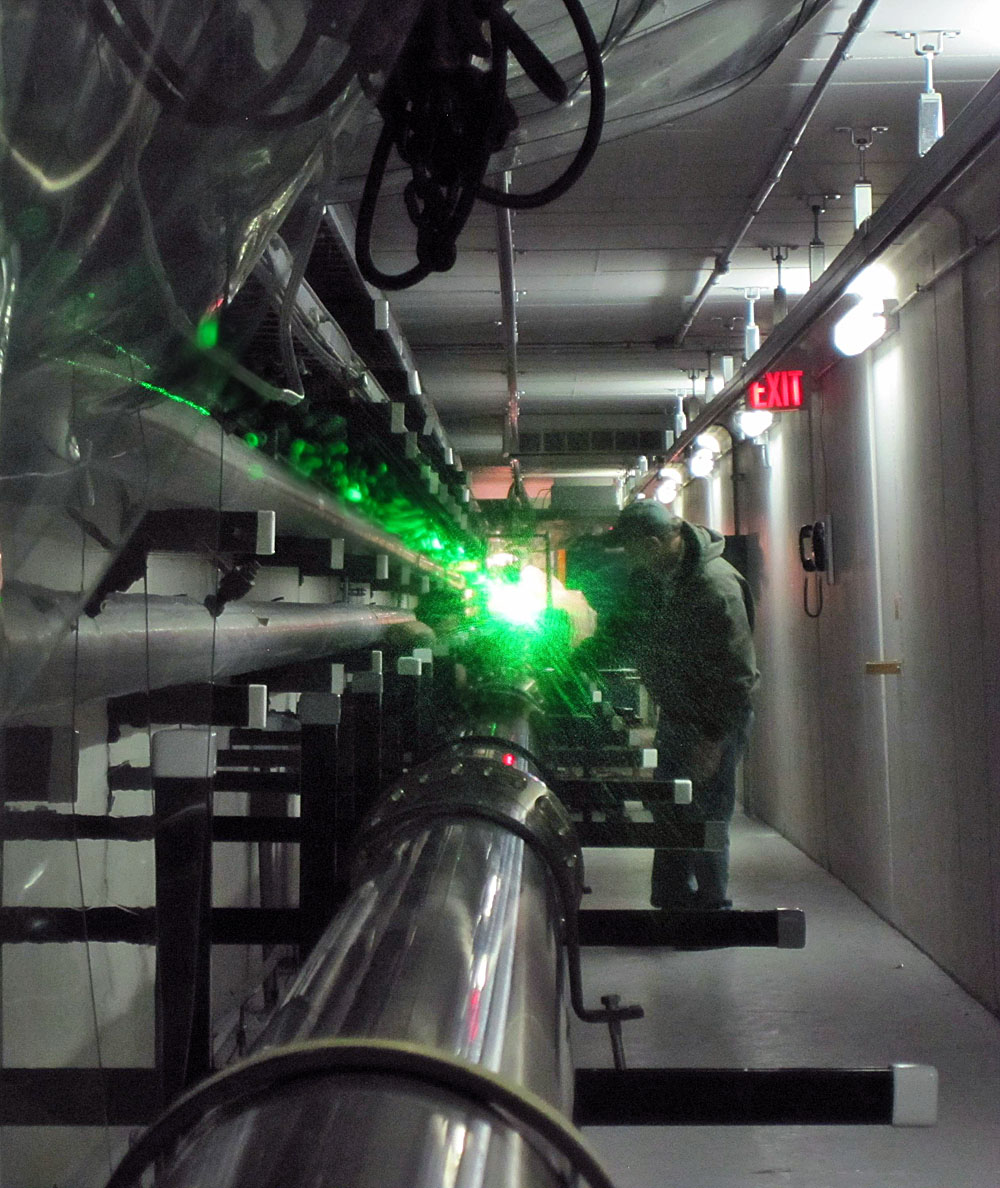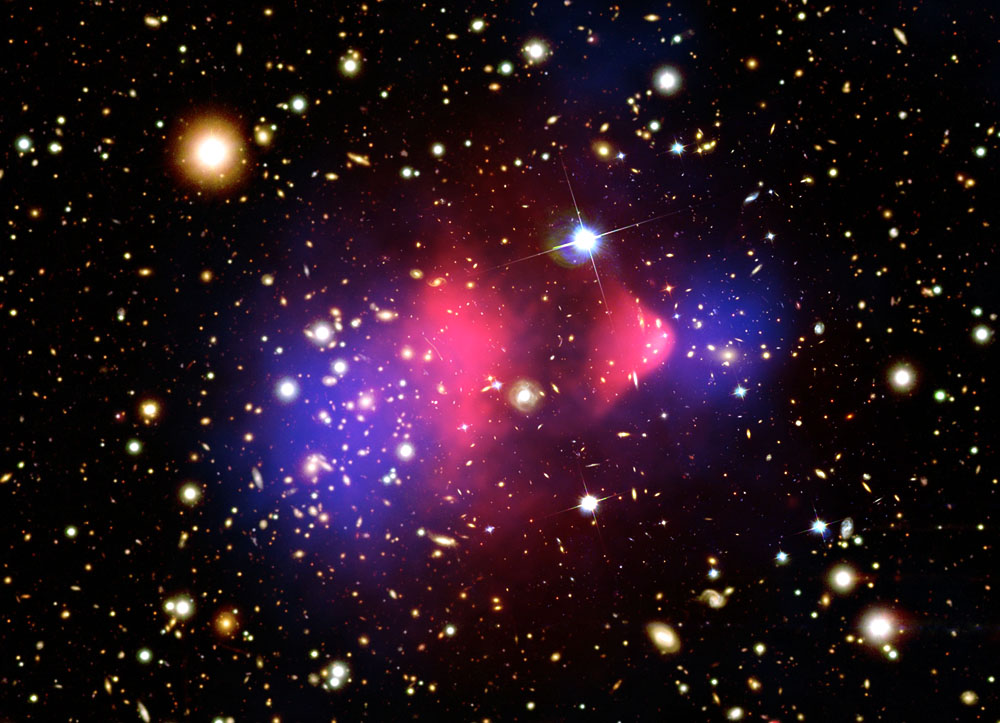 |
 |
 |
 |
 |
 |
 |
 |
 |
 |
|
KICP Workshops & Events
|
PhD Thesis Defenses, 2016 Brittany Kamai, "Hunting for MHz Gravitational Waves with the Fermilab Holometer" June 21, 2016 | 3:00 PM | Vanderbilt University - SC6333  Ph.D. Committee members: Andreas Berlind, Stephan S. Meyer, Kelly Holley-Bockelmann, Keivan Stassun and Shane Hutson "Brittany's thesis uses the Holometer data for a unique measurement of gravitational waves in the Megahertz frequency band. Her analysis sets limits on possible exotic sources of gravitational waves, such as black holes in binaries of very small mass -- radiating at frequencies ten thousand time higher than those recently measured by LIGO." - Craig J. Hogan Thesis Abstract: The highest frequency end of the gravitational wave spectrum remains poorly constrained. The early universe is capable of producing exotic candidates that could radiate at MHz frequencies. The existence of nearby sources can be tested using the Holometer, two nested 40 meter Michelson interferometers, located at Fermi National Accelerator Laboratory. Utilizing a 130-hour dataset taken between July 15, 2015 and August 15, 2015, constraints are made on both the stochastic gravitational wave background and primordial black hole binaries. This thesis demonstrates that the Holometer can be used as a ground-based gravitational wave detector which opens up an opportunity to search for sources in the 1-13 MHz range. Related Links: KICP Members: Craig J. Hogan; Stephan S. Meyer KICP Students: Brittany Kamai Jonathan Richardson, "Experimental Constraints on the Exotic Shearing of Space-Time" June 22, 2016 | 3:00 PM | ERC 401  Ph.D. Committee members: Craig Hogan, Daniel Holz, Edward Kibblewhite, Stephan S. Meyer "Jon's thesis represents an important milestone. He's done much of the critical work to make the Holometer experiment a reality. It's the most sensitive instrument ever built to study tiny random jitters of space. In his thesis, he shows that the scale of random shear jitter is more than an order of magnitude less than the Planck length, which was the theoretical expectation. The experiment essentially rules out this effect. He's working with our team now to reconfigure the machine to study the other possibility, a jitter of rotational motion, at similar sensitivity. There is some hope that this effect in the laboratory may connect with the cosmic dark energy problem." - Craig J. Hogan Thesis Abstract: The Holometer program is a search for first experimental evidence that space-time has quantum structure. The detector consists of a pair of co-located 40-m power-recycled interferometers whose outputs are read out synchronously at 50 MHz, achieving sensitivity to spatially-correlated fluctuations in differential position on time scales shorter than the light-crossing time of the instruments. Unlike gravitational wave interferometers, which time-resolve transient geometrical disturbances in the spatial background, the Holometer is searching for a universal, stationary quantization noise of the background itself. This dissertation presents the final results of the Holometer Phase I search, an experiment configured for sensitivity to exotic coherent shearing fluctuations of space-time. Measurements of high-frequency cross-spectra of the interferometer signals obtain sensitivity to spatially-correlated effects far exceeding any previous measurement, in a broad frequency band extending to 7.6~MHz, twice the inverse light-crossing time of the apparatus. This measurement is the statistical aggregation of 2.1 petabytes of 2-byte differential position measurements obtained over a month-long exposure time. At 3-sigma significance, it places an upper limit on the coherence scale of spatial shear two orders of magnitude below the Planck length. The result demonstrates the viability of this novel spatially-correlated interferometric detection technique to reach unprecedented sensitivity to coherent deviations of space-time from classicality, opening the door for direct experimental tests of theories of relational quantum gravity. Related Links: KICP Members: Craig J. Hogan; Daniel E. Holz; Stephan S. Meyer KICP Students: Jonathan Richardson Asher Berlin, "Phenomenology of Particle Dark Matter" July 8, 2016 | 3:00 PM | ERC 401  Ph.D. Committee members: Juan Collar, Wayne Hu "Asher's work has covered a broad range of topics related to dark matter and efforts to reveal its particle nature. He has worked on theory calculations relevant to underground and space-based dark matter searches and to searches for dark matter at the Large Hadron Collider. More recently, he has worked on non-standard ways in which dark matter may be have created in the early universe." - Dan Hooper, PhD advisor Thesis Abstract: The search for dark matter incorporates a wide range of characteristic energies. In this talk, I will explore recent work related to theoretical aspects of dark matter that are sensitive to physics ranging from the QCD scale, to LHC energies, and even up to the reheating temperature following inflation. Related Links: KICP Members: Juan I. Collar; Daniel Hooper; Wayne Hu; Lian-Tao Wang KICP Students: Asher Berlin Sean Johnson, "Studies of the relationship between galaxies and the inter/circum-galactic medium" July 18, 2016 | 3:00 PM | ERC 401  Ph.D. Committee members: Andrey Kravtsov, Rich Kron, John Mulchaey, and Don York. "Sean's thesis work casts new light on the intricate physical processes that drive the baryon cycles between star-forming regions and the intergalactic space. He led an ambitious survey of the galactic environments around chemically-enriched gas revealed in strong absorption against a background source. Sean's thesis sample represents the first of its kind in terms of both the scale and depth of galaxy survey data in quasar fields. It provides a pathfinder for future large-scale studies that will combine wide-field galaxy surveys with absorption spectroscopy to advance our understanding of chemical enrichment in low-density regions away from galaxies." - Hsiao-Wen Chen, PhD advisor Thesis Abstract: Galaxies are thought to grow through star formation that is fueled by the accretion of gas in dark matter halos and from intergalactic space. In turn, star formation and active galactic nuclei drive outflows that regulate gas cooling and accretion while enriching the surrounding gas with heavy elements. The resulting enriched gaseous halos that surround galaxies are thought to dominate the baryon reservoirs capable of fueling future growth, and developing an empirical understanding of the relationship between galaxies and this surrounding gas consequently represents a key step toward a more complete understanding of galaxy evolution. The diffuse nature of galaxy halo gas renders direct emission too faint to be detected with current facilities except in extreme cases, but the gas can be readily observed as absorption features in the spectra of UV-bright background sources such as quasars. I will present a series of observational studies that provide new insights into the relationship between galaxies and surrounding diffuse baryon reservoirs through combined galaxy redshift and quasar absorption line surveys. The survey results highlight the role of galaxy environment and active galactic nuclei in galaxy evolution and their possible relation with extended halo gas reservoirs. Related Links: KICP Members: Hsiao-Wen Chen; Andrey V. Kravtsov; Richard G. Kron; Donald G. York KICP Students: Sean Johnson |





 Overview
Overview